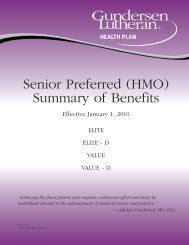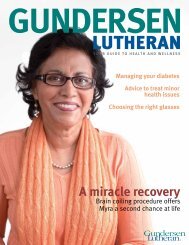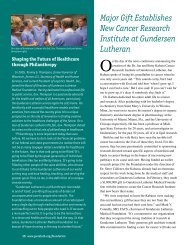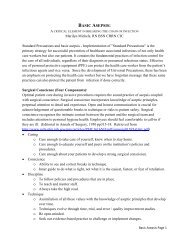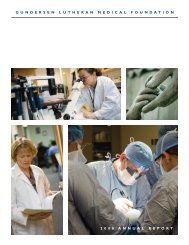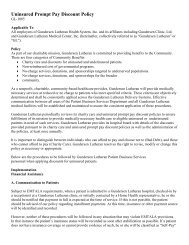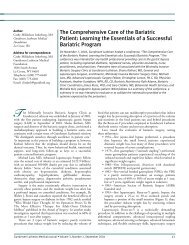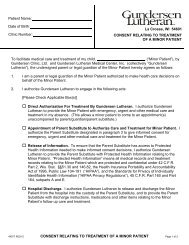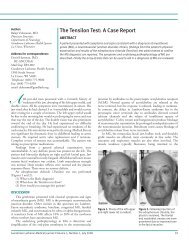ndersen er an - Gundersen Health System
ndersen er an - Gundersen Health System
ndersen er an - Gundersen Health System
Create successful ePaper yourself
Turn your PDF publications into a flip-book with our unique Google optimized e-Paper software.
gu<strong>nd<strong>er</strong>sen</strong> luth<strong>er</strong><strong>an</strong> alcohol detoxification protocol<br />
decrease absorption by up to 70%. 30 Hence, ent<strong>er</strong>al replacement<br />
of thiamine in a patient with WE is inadequate.<br />
At the blood-brain barri<strong>er</strong>, thiamine is tr<strong>an</strong>sported by both<br />
passive <strong>an</strong>d active carri<strong>er</strong>-mediated mech<strong>an</strong>isms. 31 At normal plasma<br />
concentrations, thiamine influxes into the brain almost entirely via<br />
the carri<strong>er</strong>-mediated process at a rate essentially equal to that of<br />
thiamine turnov<strong>er</strong>. Howev<strong>er</strong>, by creating a large plasma:central<br />
n<strong>er</strong>vous system concentration gradient, thiamine stores c<strong>an</strong> be<br />
readily replaced within the brain by passive tr<strong>an</strong>sport alone. As<br />
ent<strong>er</strong>al absorption of thiamine is limited, IV or IM administration<br />
should be used to obtain adequate plasma concentrations. 30<br />
Sev<strong>er</strong>al studies by Cook, Thomson, <strong>an</strong>d colleagues 29,30,32-35<br />
support the use of a much high<strong>er</strong> dosage of parent<strong>er</strong>al thiamine<br />
th<strong>an</strong> what has been traditionally utilized. They have recommended<br />
that patients who are at risk or who have clinical evidence of<br />
WE receive a minimum dosage of 500 mg of IV thiamine 3 times<br />
daily for 3 days. When th<strong>er</strong>e is <strong>an</strong> effective response, thiamine<br />
should be continued at 250 mg IV daily for <strong>an</strong> additional 3 to 5<br />
days, or until clinical improvement ceases. Traditional dosages of<br />
100 mg to 200 mg of thiamine p<strong>er</strong> day w<strong>er</strong>e found to be insufficient<br />
to replete thiamine stores, improve clinical findings, or prevent<br />
p<strong>er</strong>m<strong>an</strong>ent neurologic damage or death. The estimated mortality<br />
for inadequately treated WE is 20%. 30,32 Moreov<strong>er</strong>, almost 80%<br />
of patients with untreated or und<strong>er</strong>treated WE develop Korsakoff<br />
syndrome, a p<strong>er</strong>m<strong>an</strong>ent disord<strong>er</strong> of <strong>an</strong>t<strong>er</strong>ograde <strong>an</strong>d retrograde<br />
amnesia with confabulation as a prominent feature. 12<br />
Identifying patients with WE or who are at high risk of<br />
developing WE is difficult. Nineteen p<strong>er</strong>cent of patients with<br />
WE have none of the classic triad of symptoms at presentation.<br />
Only 29% have ocular abnormalities, while only 23% have gait<br />
incoordination <strong>an</strong>d truncal ataxia at presentation. 1 Adding to the<br />
difficulty is that acute alcohol intoxication <strong>an</strong>d alcohol withdrawal<br />
c<strong>an</strong> also cause mental status ch<strong>an</strong>ges <strong>an</strong>d ataxia, <strong>an</strong>d indeed these<br />
abnormalities are often attributed to intoxication or withdrawal<br />
without consid<strong>er</strong>ation of WE.<br />
Sev<strong>er</strong>al protocols have been developed in <strong>an</strong> attempt to bett<strong>er</strong><br />
identify, <strong>an</strong>d th<strong>er</strong>efore treat, patients with high likelihood of WE.<br />
Caine et al use crit<strong>er</strong>ia of 2 of the classic triad of symptoms (mental<br />
status ch<strong>an</strong>ges, ocular abnormalities, incoordination of gait/trunk<br />
ataxia) <strong>an</strong>d presence of dietary deficiencies. 36 The Royal College of<br />
Physici<strong>an</strong>s guidelines are to treat “all patients with <strong>an</strong>y evidence of<br />
chronic alcohol misuse <strong>an</strong>d <strong>an</strong>y of the following: acute confusion,<br />
decreased conscious level, ataxia, ophthalmoplegia, memory<br />
disturb<strong>an</strong>ce, hypoth<strong>er</strong>mia with hypotension…, [<strong>an</strong>d] patients<br />
with delirium tremens…” with thiamine 500 mg IV 3 times daily.<br />
Oth<strong>er</strong> at-risk patients receive prophylactic thiamine dosing of 250<br />
mg IV daily for 3 to 5 days. 30<br />
Signific<strong>an</strong>t magnesium deficiency is common in chronic<br />
alcoholics, <strong>an</strong>d adequate replacement is also vital in treatment<br />
of WE. Magnesium s<strong>er</strong>ves as a cofactor required for normal<br />
functioning of sev<strong>er</strong>al key thiamine-dependent enzymes of<br />
carbohydrate metabolism <strong>an</strong>d neurochemical tr<strong>an</strong>smission.<br />
Studies by Traviesa demonstrated that patients with WE may<br />
well be unresponsive to parent<strong>er</strong>al thiamine administration if<br />
hypomagnesemia is present. 37-39 Th<strong>er</strong>efore, patients at high risk<br />
of WE should have magnesium levels measured <strong>an</strong>d aggressively<br />
corrected, as well.<br />
Gu<strong>nd<strong>er</strong>sen</strong> Luth<strong>er</strong><strong>an</strong>’s current inpatient alcohol detoxification<br />
protocol includes administ<strong>er</strong>ing 100 mg of thiamine daily for 3<br />
days <strong>an</strong>d gives the option of ent<strong>er</strong>al, parent<strong>er</strong>al, or IM routes.<br />
Th<strong>er</strong>e are no specific crit<strong>er</strong>ia on the current protocol to identify<br />
individuals who are at high risk or who m<strong>an</strong>ifest symptoms of<br />
WE <strong>an</strong>d th<strong>er</strong>efore would potentially benefit from high<strong>er</strong> doses of<br />
thiamine. Most of the alcohol detoxification patients, unless they<br />
are exp<strong>er</strong>iencing sev<strong>er</strong>e withdrawal symptoms requiring high<strong>er</strong><br />
dosages of IV ativ<strong>an</strong>, do not have IV access routinely placed. The<br />
majority of these patients are receiving ent<strong>er</strong>al thiamine rath<strong>er</strong><br />
th<strong>an</strong> IM as the alt<strong>er</strong>native route of administration.<br />
The case report presented h<strong>er</strong>e demonstrates that <strong>an</strong> updated<br />
alcohol detoxification protocol could prompt earli<strong>er</strong> identification<br />
<strong>an</strong>d treatment of patients with WE. Although this patient<br />
had definite improvements in his ov<strong>er</strong>all condition during<br />
hospitalization, at discharge he demonstrated memory deficits<br />
that w<strong>er</strong>e consistent with Korsakoff syndrome. Wheth<strong>er</strong> earli<strong>er</strong><br />
administration of high<strong>er</strong> dosages of IV thiamine would have<br />
ch<strong>an</strong>ged his outcome is unknown. Howev<strong>er</strong>, WE is consid<strong>er</strong>ed<br />
a medical em<strong>er</strong>gency, <strong>an</strong>d th<strong>er</strong>efore outcome is affected not<br />
only by adequate amounts of thiamine replacement but also by<br />
the timeliness of the administration. To this end, optimally the<br />
protocol would direct that the first dose of high-dosage thiamine<br />
be given while the at-risk patient is in the em<strong>er</strong>gency department.<br />
CONCLUSIONS<br />
W<strong>er</strong>nicke encephalopathy is a neuropsychiatric condition of<br />
thiamine deficiency that is und<strong>er</strong>-diagnosed <strong>an</strong>d often und<strong>er</strong>treated.<br />
Specifically, oral thiamine is not absorbed to <strong>an</strong> extent<br />
sufficient to replace thiamine stores in WE <strong>an</strong>d should not be used.<br />
High IV or IM dosages are required to attain s<strong>er</strong>um levels high<br />
enough for passive tr<strong>an</strong>sport across the blood-brain barri<strong>er</strong>.<br />
We propose a new alcohol detoxification protocol that identifies<br />
high-risk patients or those demonstrating signs of WE to receive<br />
parent<strong>er</strong>al thiamine 500 mg 3 times daily for a minimum of 3<br />
days. In addition, baseline <strong>an</strong>d daily magnesium levels should be<br />
monitored <strong>an</strong>d replaced if necessary.<br />
REFERENCES<br />
1. Harp<strong>er</strong> CG, Giles M, Finlay-Jones R. Clinical signs in the W<strong>er</strong>nicke-Korsakoff<br />
complex: a retrospective <strong>an</strong>alysis of 131 cases diagnosed at necropsy. J Neurol<br />
Neurosurg Psychiatry. 1986;49(4):341-345.<br />
2. T<strong>an</strong>phaichitr V. Thiamine. In: Shils ME, Olson JA, Shike M, Ross AC, eds.<br />
Mod<strong>er</strong>n Nutrition in <strong>Health</strong> <strong>an</strong>d Disease. 9th ed. Baltimore: Williams & Wilkins;<br />
1999:381-389.<br />
3. Torvik A, Lindboe CF, Rogde S. Brain lesions in alcoholics. A neuropathological<br />
study with clinical correlations. J Neurol Sci. 1982;56(2-3):233-248.<br />
4. Sechi GP, Bosincu L, Cossu Rocca P, Dei<strong>an</strong>a GA, Correddu P, Murrighile RM.<br />
Hyp<strong>er</strong>th<strong>er</strong>mia, choreic dyskinesias <strong>an</strong>d increased motor tone in W<strong>er</strong>nicke’s<br />
encephalopathy. Eur J Neurol. 1996;3(Suppl 5):133.<br />
5. Doss A, Mahad D, Rom<strong>an</strong>owski CA. W<strong>er</strong>nicke encephalopathy: unusual findings<br />
in nonalcoholic patients. J Comput Assist Tomogr. 2003;27(2):235-240.<br />
6. Sechi G, S<strong>er</strong>ra A. W<strong>er</strong>nicke’s encephalopathy: new clinical settings <strong>an</strong>d recent<br />
adv<strong>an</strong>ces in diagnosis <strong>an</strong>d m<strong>an</strong>agement. L<strong>an</strong>cet Neurol. 2007;6(5):442-455.<br />
7. W<strong>er</strong>nicke C. Die akute haemorrhagische polioencephalitis sup<strong>er</strong>ior. In: Lehrbuch<br />
D<strong>er</strong> Gehirnkr<strong>an</strong>kheiten Für A<strong>er</strong>zte Und Studirende, Bd II. Vol II. Kassel und B<strong>er</strong>lin:<br />
Fisch<strong>er</strong>; 1881:229-242.<br />
Gu<strong>nd<strong>er</strong>sen</strong> Luth<strong>er</strong><strong>an</strong> Medical Journal • Volume 5, Numb<strong>er</strong> 1, July 2008 15




